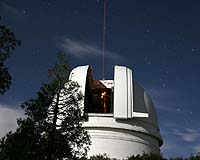 |
Paris, France (SPX) Jun 22, 2009 The next generation of instruments for ground-based telescopes took a leap forward with the development of a new ultra-fast camera that can take 1500 finely exposed images per second even when observing extremely faint objects. The first 240x240 pixel images with the world's fastest high precision faint light camera were obtained through a collaborative effort between ESO and three French laboratories from the French Centre National de la Recherche Scientifique/Institut National des Sciences de l'Univers (CNRS/INSU). Cameras such as this are key components of the next generation of adaptive optics instruments of Europe's ground-based astronomy flagship facility, the ESO Very Large Telescope (VLT). "The performance of this breakthrough camera is without an equivalent anywhere in the world. The camera will enable great leaps forward in many areas of the study of the Universe," says Norbert Hubin, head of the Adaptive Optics department at ESO. OCam will be part of the second-generation VLT instrument SPHERE. To be installed in 2011, SPHERE will take images of giant exoplanets orbiting nearby stars. A fast camera such as this is needed as an essential component for the modern adaptive optics instruments used on the largest ground-based telescopes. Telescopes on the ground suffer from the blurring effect induced by atmospheric turbulence. This turbulence causes the stars to twinkle in a way that delights poets, but frustrates astronomers, since it blurs the finest details of the images. Adaptive optics techniques overcome this major drawback, so that ground-based telescopes can produce images that are as sharp as if taken from space. Adaptive optics is based on real-time corrections computed from images obtained by a special camera working at very high speeds. Nowadays, this means many hundreds of times each second. The new generation instruments require these corrections to be done at an even higher rate, more than one thousand times a second, and this is where OCam is essential. "The quality of the adaptive optics correction strongly depends on the speed of the camera and on its sensitivity," says Philippe Feautrier from the LAOG, France, who coordinated the whole project. "But these are a priori contradictory requirements, as in general the faster a camera is, the less sensitive it is." This is why cameras normally used for very high frame-rate movies require extremely powerful illumination, which is of course not an option for astronomical cameras. OCam and its CCD220 detector, developed by the British manufacturer e2v technologies, solve this dilemma, by being not only the fastest available, but also very sensitive, making a significant jump in performance for such cameras. Because of imperfect operation of any physical electronic devices, a CCD camera suffers from so-called readout noise. OCam has a readout noise ten times smaller than the detectors currently used on the VLT, making it much more sensitive and able to take pictures of the faintest of sources. "Thanks to this technology, all the new generation instruments of ESO's Very Large Telescope will be able to produce the best possible images, with an unequalled sharpness," declares Jean-Luc Gach, from the Laboratoire d'Astrophysique de Marseille, France, who led the team that built the camera. "Plans are now underway to develop the adaptive optics detectors required for ESO's planned 42-metre European Extremely Large Telescope, together with our research partners and the industry," says Hubin. Using sensitive detectors developed in the UK, with a control system developed in France, with German and Spanish participation, OCam is truly an outcome of a European collaboration that will be widely used and commercially produced. Share This Article With Planet Earth
Related Links ESO Astronomy News from Skynightly.com
 Unique Sky Survey Brings New Objects Into Focus
Unique Sky Survey Brings New Objects Into FocusSan Diego CA (SPX) Jun 17, 2009 An innovative sky survey has begun returning images that will be used to detect unprecedented numbers of powerful cosmic explosions - called supernovae - in distant galaxies, and variable brightness stars in our own Milky Way. The survey also may soon reveal new classes of astronomical objects. All of these discoveries will stem from the Palomar Transient Factory (PTF) survey, which combin ... read more |
|
| The content herein, unless otherwise known to be public domain, are Copyright 1995-2009 - SpaceDaily. AFP and UPI Wire Stories are copyright Agence France-Presse and United Press International. ESA Portal Reports are copyright European Space Agency. All NASA sourced material is public domain. Additional copyrights may apply in whole or part to other bona fide parties. Advertising does not imply endorsement,agreement or approval of any opinions, statements or information provided by SpaceDaily on any Web page published or hosted by SpaceDaily. Privacy Statement |